This problem solving activity has a statistics focus.
Fred lays tiles. He has a big 1 metre by 1 metre square tile for part of Sue’s new kitchen floor in front of her fridge.
But he breaks it as he is putting it down.
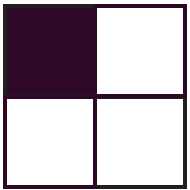
He lays three of these tiles perfectly, but as he is putting the last one in place he breaks it.
Fred can’t replace these new smaller tiles, so, in the hole where the broken one should have gone, he lays four even smaller tiles.
He lays three of these tiles perfectly. but as he is putting in the last one he breaks it.
This happens another two times. How many possible ways could Fred have laid the tiles on Sue’s kitchen floor?
How many possible ways could Fred have laid the floor if he broke 100 tiles?
- Use a pattern to count in a geometrical situation.
- Devise and use problem solving strategies to explore situations mathematically (make a drawing, use equipment).
The problem requires students to find how many ways a 1 square metre part of floor can be tiled, to keep track of their findings, and to look for patterns in the numbers associated with the resulting tessellations.
In this problem the numbers form a geometric sequence. Such a sequence requires a fixed number to multiply each term in order to get the next one. The sequence 2, 6, 18, 54, … is a geometric sequence where the fixed number that does the multiplying is 3.
This is one of three parallel problems: The Clumsy Tiler A, Geometry, Level 4 and The Clumsy Tiler B, Number, Level 4.
- Copymaster of the problem (Māori)
- Copymaster of the problem (English)
- Some square pieces of cardboard
- Calculators
The Problem
Fred lays tiles. He has a big 1 metre by 1 metre square tile for part of Sue’s new kitchen floor in front of her fridge. But he breaks it as he is putting it down.
Fred can’t replace the tile, but he finds four square tiles to fill the space of the big one. He lays three of these tiles perfectly, but as he is putting the last one in place he breaks it.
Fred can’t replace these new smaller tiles, so, in the hole where the broken one should have gone, he lays four even smaller tiles. He lays three of these tiles perfectly. but as he is putting in the last one he breaks it.
This happens another two times. How many possible ways could Fred have laid the tiles on Sue’s kitchen floor?
How many possible ways could Fred have laid the floor if he broke 100 tiles?
Teaching Sequence
- Ask the students if they have been in any rooms that have tiles on the floor.
- Tell them about Fred and ask:
What did his first tile look like?
What did the second one look like?
How were his first three tiles laid? In how many ways could this be done?
Can you see any patterns?
Help the students to realise that, because there is a fridge next to the tiles, the square area is fixed at one end. This means that there are four ways to tile the floor with the first three tiles. - Repeat Fred’s story. Have them work in groups to solve the problem.
- As they work ensure that they are recording their solutions.
- Support them with questions, and pose the extension problem as appropriate.
- Ask one or two of the groups to share how they solved the problem. Make sure that everyone has a good idea of how to do it.
- Some of the students who worked on the Extension problem might like to report back too.
Extension
How many different ways are there of tiling Sue’s square metre, if Fred replaces one tile at each stage by 9. (Of course, he breaks one of these at each stage too.)
Solution
When Fred is tiling with the first three tiles he can leave a space in 4 places. Hence at the first stage, there are 4 ways that the floor can be tiled. We show these 4 ways below
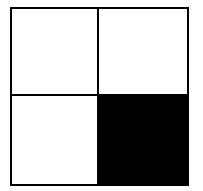
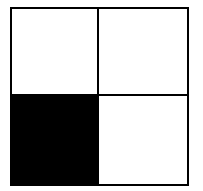
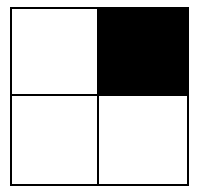
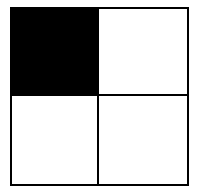
At the next stage, the three new tiles can go into the blank space in the diagrams above. Again, in each diagram they can be laid in 4 ways. This gives rise to 16 tilings.
At every new stage, each diagram leads to 4 new tilings. So we progressively get 16 x 4 = 64 tilings, then 64 x 4 = 256 tilings, and then 256 x 4 = 1024. Since for the first part of the question there are five stages, we get 1024 tilings at this point.
Now what if there were 100 breakages? Spot the pattern. Each new stage gives rise to a factor of 4 more tilings. So for 100 stages we’ll get 4 x 4 … x 4 tilings (with 100 4s).
Solution to the Extension
The only difference with 9 tiles is that there are 9 possible ways that we could have a tile missing. At the first stage then, there will be 9 possible ways to tile the square. But at the next stage we get 9 different possibilities for each of the 9 tilings. So after 5 stages we have 9 x 9 x 9 x 9 x 9 = 59049.
After 100 stages we’ll have 9 multiplied by itself 100 times. That’s a colossal number. It’s about 26 with 94 zeros after it. Something like
260 000 000 000 000 000 000 000 000 000 000 000 000 000 000 000 000 000 000 000 000 000 000 000 000 000 000 000 000 000 000 000 000 000 000 000 000 000 000 000 000 000 000 000 000 000 000 000 000 000 000 000 000 000 000 000 000 000 000 000 000 000.